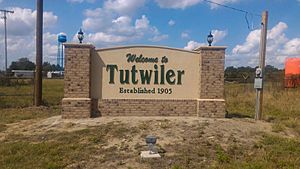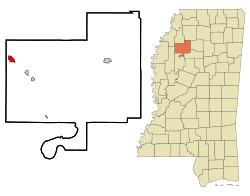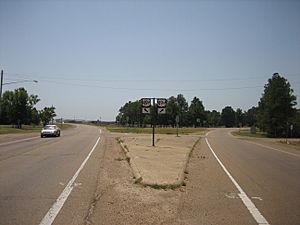Tutwiler, Mississippi facts for kids
Quick facts for kids
Tutwiler, Mississippi
|
|
|---|---|
 |
|

Location of Tutwiler, Mississippi
|
|
| Country | United States |
| State | Mississippi |
| County | Tallahatchie |
| Area | |
| • Total | 2.77 sq mi (7.17 km2) |
| • Land | 2.77 sq mi (7.17 km2) |
| • Water | 0.00 sq mi (0.00 km2) |
| Elevation | 154 ft (47 m) |
| Population
(2020)
|
|
| • Total | 2,476 |
| • Density | 894.19/sq mi (345.28/km2) |
| Time zone | UTC-6 (Central (CST)) |
| • Summer (DST) | UTC-5 (CDT) |
| ZIP code |
38963
|
| Area code(s) | 662 |
| FIPS code | 28-75040 |
| GNIS feature ID | 2406769 |
Tutwiler is a small town in Tallahatchie County, Mississippi, United States. In 2020, about 2,476 people lived there.
Contents
History of Tutwiler
How Tutwiler Started
The town of Tutwiler was named after Tom Tutwiler. He was a civil engineer for a local railroad. In 1899, he set up his main office seven miles northwest of Sumner.
When the railroad was built, the first building was a two-story depot. The railroad let the town use the top floor as a public school. Captain H.B. Fitch opened the first store in town. His wife became the teacher for the school, which started with only five students.
In 1905, Tutwiler officially became a town. W.E. Fite was chosen as the first Mayor. The Illinois Central Railroad built a railroad yard in Tutwiler in 1900. This railroad connected Yazoo City to Lambert.
Growth and Changes
A high school was built in 1928. The town grew quickly until 1929. That year, the railroad yard moved to Clarksdale. After that, businesses and the number of people living in Tutwiler started to decrease. In 1929, before the railroad yard moved, 1,010 people lived in the town.
The Birthplace of the Blues
Like many towns in the Mississippi Delta, Tutwiler is known as a "birthplace of the blues". This is where W. C. Handy reportedly "discovered" the blues in 1903. He was waiting for a train on the platform in town.
Handy had heard music similar to the blues before. But while waiting for a train to Memphis, he heard a traveling blues musician. This musician was playing a slide guitar and singing about "goin' where the Southern cross the Dog." This referred to where the Southern Railway and Yazoo and Mississippi Valley Railroad met. People locally called the Yazoo and Mississippi Valley Railroad the "Yellow Dog." Handy described it as "the weirdest music I had ever heard."
A special marker for the Mississippi Blues Trail was put up here on November 25, 2009. It honors W.C. Handy. The musician Robert Plant paid for this marker. He attended the event and spoke about how the blues influenced him. He mentioned that his mother bought him a record by Sonny Boy Williamson II, which he played often. Sonny Boy Williamson II is buried near Tutwiler. Robert Plant and Jimmy Page often visit Tutwiler to connect with the music that changed their lives.
Tutwiler was also the childhood home of famous blues musicians John Lee Hooker and Frank Stokes.
W.C. Handy and his family lived in Tutwiler for six years. In 1903, he wrote about his experience waiting for a train:
A lean loose-jointed Negro had commenced plunking a guitar beside me while I slept ... As he played, he pressed a knife on the strings of the guitar in a manner popularized by Hawaiian guitarists who used steel bars. ... The singer repeated the line three times, accompanying himself on the guitar with the weirdest music I had ever heard.
Geography of Tutwiler
The town of Tutwiler covers about 1.3 square miles (3.4 square kilometers) of land. It is located about 70 miles (113 kilometers) south of Memphis, Tennessee.
Population Data
| Historical population | |||
|---|---|---|---|
| Census | Pop. | %± | |
| 1900 | 142 | — | |
| 1910 | 410 | 188.7% | |
| 1920 | 1,010 | 146.3% | |
| 1930 | 873 | −13.6% | |
| 1940 | 665 | −23.8% | |
| 1950 | 939 | 41.2% | |
| 1960 | 912 | −2.9% | |
| 1970 | 1,103 | 20.9% | |
| 1980 | 1,174 | 6.4% | |
| 1990 | 1,391 | 18.5% | |
| 2000 | 1,364 | −1.9% | |
| 2010 | 3,550 | 160.3% | |
| 2020 | 2,476 | −30.3% | |
| U.S. Decennial Census | |||
2020 Census Information
| Race | Number of People | Percentage |
|---|---|---|
| White | 527 | 21.28% |
| Black or African American | 1,583 | 63.93% |
| Native American | 1 | 0.04% |
| Other/Mixed | 9 | 0.36% |
| Hispanic or Latino | 356 | 14.38% |
As of the 2020 United States Census, Tutwiler had 2,476 people. There were 323 households and 206 families living in the town.
Economy in Tutwiler
For a long time, the economy of Tutwiler mostly depended on cotton. In 2001, many residents worked in prisons in the Mississippi Delta. Others worked at casinos in Tunica Resorts or at poultry processing plants nearby.
The town's only bank and a grain elevator closed in 2000. In 2001, Tutwiler did not have any clothing stores, drugstores, or restaurants.
The Prison's Impact
The Tallahatchie County Correctional Facility is a private prison located near Tutwiler. It is operated by the Corrections Corporation of America. Around 1998, town leaders decided to support building the prison. They hoped it would create many jobs.
To help the prison, the town built a sewage lagoon and a water tower. The State of Mississippi and Tallahatchie County helped pay to train the prison guards. When the facility opened in 2000, it seemed like a great help for Tutwiler. Many local people got jobs as prison guards. The prison's monthly payroll was about $467,000.
However, in 2001, the number of prisoners decreased a lot. This caused the prison to reduce its employees from 208 to 40. Hundreds of people lost their jobs. By the end of 2001, the monthly payroll dropped to $80,000.
In June 2003, the prison received 1,423 inmates from Alabama. The prison then hired 250 new employees. By 2010, the prison also held prisoners from California.
Education in Tutwiler
The West Tallahatchie School District serves the town of Tutwiler. Students in Tutwiler attend R.H. Bearden Elementary School near Sumner. They go to West Tallahatchie High School near Webb.
Hopson Bayou Elementary School used to serve children in Tutwiler. It closed as a regular school in 1993. It then became a special school for students needing extra support. In 1997, this special school moved to the former Sumner Elementary building.
Some children in Tutwiler also attend private schools. These include the North Sunflower Academy in unincorporated Sunflower County. Others go to Delta Academy in Marks or Lee Academy in Clarksdale.
Religion in Tutwiler
Tutwiler has many Christian churches. These include Baptist, Church of God In Christ, Protestant, and non-denominational churches.
Seven Catholic nuns and their team run community services in the town. They mainly work at the Tutwiler Community Education Center, which started in 1993. They host town meetings and voting. They also run programs for children and senior citizens. They operate a health clinic and take care of the grave of Sonny Boy Williamson II.
In 1983, Sister Anne Brooks, a nun, came to Tutwiler to manage the Tutwiler Clinic. Before she arrived, the clinic had separate waiting rooms for different races. As of 2010, the clinic had been helping people for 27 years. In November 2010, the nuns opened a new gymnasium. Donors from outside the area helped pay for it. A journalist from The New York Times said the gym was "worthy of a university."
Notable People from Tutwiler
- John Lee Hooker—a famous blues singer, was born near Tutwiler.
- Mary Martha Presley Merritt, a politician, was born here.
- Aldon Morris, a scholar.
- Sonny Boy Williamson II—a blues singer and harmonica player, was born near Tutwiler.
Images for kids
See also
 In Spanish: Tutwiler para niños
In Spanish: Tutwiler para niños





